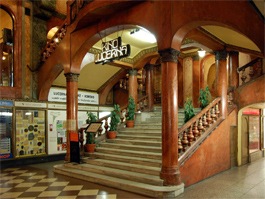
Václav Havel built in Prague a Secession gem of European format
 |
When Václav Havel presented the facade design of a new project on Vodějavská Street to his wife in 1908, she remarked that it reminded her of a large lantern. That would be a good name for the whole building, the builder thought. It's a Czech word that even a foreigner could pronounce. And quite suitable for the planned representative spaces intended for culture, relaxation, and sport.
The unique reinforced concrete structure of the complex, which had previously only been used for industrial buildings, allowed Czech structural engineer Stanislav Bechyně to place the largest hall three floors underground. Havel wanted to create a huge underground ice rink modeled after Berlin. Instead, a giant social hall was eventually built.
Similarly, today's Lucerna cinema originally served as a theater hall and even hosted the opera Dalibor. But then Havel had a dispute with the then-head of the National Theater's opera, Karel Kovařovic, and the theater hall was transformed into a cinema.
The entire complex in the center of Prague gradually emerged between 1907 and 1921. The Art Nouveau palace was the first reinforced concrete building in Prague to have a covered and glazed passage, which had been unseen in Bohemia until then. Many significant social events took place within its halls, continuing to this day.
It also offered housing and housed the beautiful tea house Jokohama. Founded by traveler Joe Hloucha, its atmosphere evoked the ambiance of real Japanese tea houses. The furniture was made of rattan, and the girls serving tea wore authentic Japanese kimonos.
The first dining automat in Prague was also located here, where customers were served by girls referred to as Růženky. Prague residents could visit a painting and photography studio or a variety of shops with artistic items or fashion.
The Havel family was among the well-known miller families in Prague in the 18th and 19th centuries. The mill, which was managed by generations of the family, stood on the left bank of the Vltava River and bore the descriptive number 87.
The milling tradition was interrupted by Václav Julius Havel (1821-1884), who had to pay off an inheritance to his stepmother and dowry to eight sisters, thus needing to sell the mill. He began working for the state railway and moved to Malá Strana. His son Václav was born there on March 23, 1861.
After finishing primary school, he moved on to the Prague Polytechnic but did not complete his studies due to financial reasons. In 1884, he even had to borrow money for his father's funeral.
He gained his first contracts as a paving entrepreneur in the countryside. To establish a construction company, he had to team up with several established builders. But he thrived; contracts quickly increased, and the Havel family soon joined Prague's elite.
"For example, grandfather established the first winter ice rink in Prague on Primátorský Island, where the elite of society gathered. Then he and grandmother bought a large estate in Zběšičky near Milevsko, which eventually transformed into several Prague parcels, on which grandfather began building apartment houses," recalled Ivan Havel, son of Václav's son Miloš.
Havel also built modern apartment houses in New Town. In 1912, he founded the film company Lucerna-film and owned five cinemas in Prague. In 1917, the company was taken over by his sons Václav and Miloš. Václav built the Barrandov terraces, while Miloš established the Barrandov film studios.
Václav Havel passed away on September 6, 1921. In the same year, a bust created by Jan Štursa was unveiled at the entrance to the large hall of Lucerna.
The English translation is powered by AI tool. Switch to Czech to view the original text source.
2 comments
add comment
Subject
Author
Date
Lucerna
robert
21.03.11 08:34
Lucerna
animulacz
24.03.11 12:42
show all comments
Related articles
0
24.06.2024 | Havlová sold a majority stake in the Lucerna Palace for one billion to the BTL group
0
12.06.2018 | The Lucerna Palace in Prague will have a new facade
1
17.08.2017 | The roofs of the Lucerna Palace will open to the public for a week
0
20.02.2017 | Invalidovna and Lucerna have become national cultural monuments
0
19.10.2016 | The roof of the Lucerna Palace will temporarily open to the public
0
18.06.2016 | The guide shows Prague buildings associated with the life of Václav Havel
0
01.06.2016 | The owners want to register the Lantern as a national cultural monument
0
17.10.2012 | The reconstruction should restore the Lucerna Palace to its former glory
0
25.11.2009 | Celebration of the 100th anniversary of the Prague cinema Lucerna










